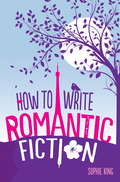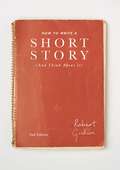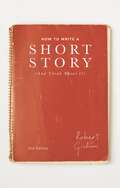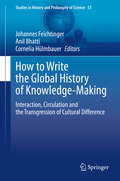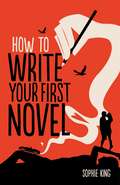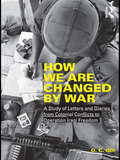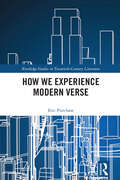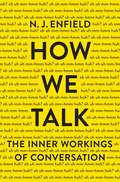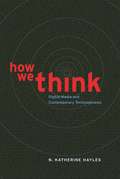- Table View
- List View
How To Write Romantic Fiction
by Sophie KingRomantic fiction is one of the most competitive areas for a writer to crack. Whether you’re a beginner or an already-published writer, you’ll find something new here.This book will help you to write novels that both sizzle and sell. You'll learn how to dream up heroes and heroines who breathe (heavily) from the page, plan plots to keep the reader up all night, find a happy ending, which is both surprising and believable - and most importantly get published!
How to Write Short: Word Craft for Fast Times
by Roy Peter ClarkAmerica's most influential writing teacher offers an engaging and practical guide to effective short-form writing. In How to Write Short, Roy Peter Clark turns his attention to the art of painting a thousand pictures with just a few words. Short forms of writing have always existed-from ship logs and telegrams to prayers and haikus. But in this ever-changing Internet age, short-form writing has become an essential skill. Clark covers how to write effective and powerful titles, headlines, essays, sales pitches, Tweets, letters, and even self-descriptions for online dating services. With examples from the long tradition of short-form writing in Western culture, How to Write Short guides writers to crafting brilliant prose, even in 140 characters.
How to Write Short Stories and Get Them Published: A Comprehensive Guide to Writing Short Fiction
by Ashley ListerThis book will help you plot like a pro, master the art of suspense like Poe, craft captivating dialogue like Twain and - most crucially - get your short stories published.How to Write Short Stories and Get Them Published is the essential guide to writing short fiction. It takes the aspiring writer from their initial idea through to potential outlets for publication and pitching proposals to publishers. Along the journey this guide considers the most important aspects of creative writing, such as character, plot, point of view, description and dialogue. All of these areas are illustrated with examples of classic fiction, and accompanied by exercises that will help every writer hone their natural skill and talent into the ability to craft compelling short stories.
How to Write A Short Story (And Think About It)
by Robert GrahamShort story publishing is flourishing in the twenty-first century and is no longer seen as a poor relation of the novel. But what is a short story? And how do you write one? Robert Graham takes you through everything you need to know, from how a writer works to crafting and editing your own fiction. This heavily revised edition features new chapters by contemporary fiction writers. Stressing the importance of reading broadly and deeply, the book includes a wide range of prompts and writing exercises. It teaches you how to read as a writer and write like somebody who has read. You will learn the elements of craft you need to produce short stories, and one of the key writer’s disciplines: reflecting on your own work. Whether you are a student or an experienced author, this book will teach you how to write short stories – and reflect on the creative processes involved. The book features chapters from writer-teachers James Friel, Rodge Glass, Ursula Hurley, Heather Leach, Helen Newall, Jenny Newman, James Rice and Tom Vowler.
How to Write A Short Story (And Think About It)
by Robert GrahamShort story publishing is flourishing in the 21st century and is no longer seen as a poor relation of the novel. But what is a short story? And how do you write one? Robert Graham takes you through everything you need to know, from how a writer works to crafting and editing your own fiction.This heavily revised edition features new chapters by contemporary fiction writers. Stressing the importance of reading broadly and deeply, the book includes a wide range of prompts and writing exercises. It teaches you how to read as a writer and write like somebody who has read. You will learn the elements of craft you need to produce short stories, and one of the key writer's disciplines: reflecting on your own work. Whether you are a student or an experienced author, this book will teach you how to write short stories – and reflect on the creative processes involved. The book features chapters from writer-teachers James Friel, Rodge Glass, Ursula Hurley, Heather Leach, Helen Newall, Jenny Newman, James Rice and Tom Vowler.
How to Write the Global History of Knowledge-Making: Interaction, Circulation and the Transgression of Cultural Difference (Studies in History and Philosophy of Science #53)
by Johannes Feichtinger Anil Bhatti Cornelia HülmbauerThis multidisciplinary collection of essays provides a critical and comprehensive understanding of how knowledge has been made, moved and used, by whom and for what purpose. To explain how new knowledge emerges, this volume offers a two-fold conceptual move: challenging both the premise of insurmountable differences between confined, autarkic cultures and the linear, nation-centered approach to the spread of immutable stocks of knowledge. Rather, the conceptual focus of the book is on the circulation, amalgamation and reconfiguration of locally shaped bodies of knowledge on a broader, global scale. The authors emphasize that the histories of interaction have been made less transparent through the study of cultural representations thus distorting the view of how knowledge is actually produced.Leading scholars from a range of fields, including history, philosophy, social anthropology and comparative culture research, have contributed chapters which cover the period from the early modern age to the present day and investigate settings in Africa, Asia, and Europe. Their particular focus is on areas that have largely been neglected until now. In this work, readers from many disciplines will find new approaches to writing the global history of knowledge-making, especially historians, scholars of the history and philosophy of science, and those in culture studies.
How To Write Your First Novel
by Sophie KingLet best-selling novelist Sophie King guide you through the whole process of writing your first novel and getting it published.This revised edition takes aspiring novelists through the steps of writing a novel, from finding that initial idea, to keeping the plot going and crafting the perfect ending. With helpful exercises in each chapter you will learn how to:- Develop a brilliant idea for your first novel - Create characters that will make your novel come alive - Plot your novel so that your readers simply have to turn the page - Unravel the mysteries of viewpoint - Create realistic dialogue and settings so your readers feel they are there - Find your own voice. - Most importantly, the book includes tips and advice on how to get published. This new edition also includes a ten step guide to revision so that you can polish your novel to be the best it can be.
How To Write Your Life Story in Ten Easy Steps: 'what Splendid Guide To Writing The Story Of Your Life!'
by Sophie KingWriting your life story is one of the greatest gifts you can give your family. In writing it you will find yourself drawing even closer to your children and grandchildren. You will also find it an exciting and fascinating process, one that helps you to make sense of your own life. Writing your own life story is also a very good way for creative writers to find inspiration and get started in the habit of writing. This step-by-step guide will steer you through different ways of telling your life story, in ten easy steps: * HOW TO BEGIN * USING THE POWER OF MEMORY * HOW TO START YOUR RESEARCH * DIFFERENT WAYS OF STRUCTURING YOUR LIFE STORY * HOWTO MAKE YOUR LIFE STORY STAND OUT WITH PICTURES, COLOURS AND SMELLS, ETC * HOW TO PROVIDE A CONTEMPORARY FEEL TO YOUR LIFE STORY * BRINGING THE REST OF THE WORLD INTO YOUR STORY * HOWTO END YOUR LIFE STORY AND MAKE SURE THAT IT DOESN T HURT ANYONE (INCLUDING YOURSELF) * HOW TO PRESENT YOUR LIFE STORY AND GET IT PUBLISHED *STORIES TO INSPIRE YOU / Nowadays, you can publish your life story should you want to do so. For a small amount of money, you can get a few bound copies or you can publish it free on the net. Don’t miss this wonderful opportunity to write an heirloom which will last for ever.
How to Write Your Undergraduate Dissertation (PDF)
by Bryan GreethamUnlike any other book this teaches students how to generate their own ideas and develop them into original research projects. Using examples from all disciplines, it not only teaches students how to plan and research using all the qualitative and quantitative techniques and instruments, but also how to construct arguments and use evidence and language consistently. Throughout it emphasizes that writing is the most difficult form of thinking and dissertations are a test of our ability both to think and write clearly.
How To Write Your Undergraduate Dissertation (PDF)
by Bryan GreethamUnlike any other book this teaches students how to generate their own ideas and develop them into original research projects. Using examples from all disciplines, it not only teaches students how to plan and research using all the qualitative and quantitative techniques and instruments, but also how to construct arguments and use evidence and language consistently. Throughout it emphasizes that writing is the most difficult form of thinking and dissertations are a test of our ability both to think and write clearly.
How Traditions Live and Die (Foundations of Human Interaction)
by Olivier MorinOf all the things we do and say, most will never be repeated or reproduced. Once in a while, however, an idea or a practice generates a chain of transmission that covers more distance through space and time than any individual person ever could. What makes such transmission chains possible? For two centuries, the dominant view (from psychology to anthropology) was that humans owe their cultural prosperity to their powers of imitation. In this view, modern cultures exist because the people who carry them are gifted at remembering, storing and reproducing information. How Traditions Live and Die proposes an alternative to this standard view. What makes traditions live is not a general-purpose imitation capacity. Cultural transmission is partial, selective, often unfaithful. Some traditions live on in spite of this, because they tap into widespread and basic cognitive preferences. These attractive traditions spread, not by being better retained or more accurately transferred, but because they are transmitted over and over. This theory is used to shed light on various puzzles of cultural change (from the distribution of bird songs to the staying power of children's rhymes) and to explain the special relation that links the human species to its cultures. Morin combines recent work in cognitive anthropology with new advances in quantitative cultural history, to map and predict the diffusion of traditions. This book is both an introduction and an accessible alternative to contemporary theories of cultural evolution.
HOW TRADITIONS LIVE & DIE FHI C (Foundations of Human Interaction)
by Olivier MorinOf all the things we do and say, most will never be repeated or reproduced. Once in a while, however, an idea or a practice generates a chain of transmission that covers more distance through space and time than any individual person ever could. What makes such transmission chains possible? For two centuries, the dominant view (from psychology to anthropology) was that humans owe their cultural prosperity to their powers of imitation. In this view, modern cultures exist because the people who carry them are gifted at remembering, storing and reproducing information. How Traditions Live and Die proposes an alternative to this standard view. What makes traditions live is not a general-purpose imitation capacity. Cultural transmission is partial, selective, often unfaithful. Some traditions live on in spite of this, because they tap into widespread and basic cognitive preferences. These attractive traditions spread, not by being better retained or more accurately transferred, but because they are transmitted over and over. This theory is used to shed light on various puzzles of cultural change (from the distribution of bird songs to the staying power of children's rhymes) and to explain the special relation that links the human species to its cultures. Morin combines recent work in cognitive anthropology with new advances in quantitative cultural history, to map and predict the diffusion of traditions. This book is both an introduction and an accessible alternative to contemporary theories of cultural evolution.
How We Are Changed by War: A Study of Letters and Diaries from Colonial Conflicts to Operation Iraqi Freedom
by D.C. GillThe prolonged conflict in Iraq has shown us war’s transformative effect. Civilians rivet themselves to events happening halfway around the world, while young soldiers return home from battlefields, coping with the memories of those events. How We Are Changed by War examines our sense of ourselves through the medium of diaries and wartime correspondence, beginning with the colonists of the early seventeenth century, and ending with the diaries and letters from Iraqi war vets. The book tracks the effects of war in private writings regardless of the narrator’s historical era allowing the writers to ‘speak’ to each other across time to reveal a profound commonality of cultural experience. Finally, interpreting the narratives by how the writers conveyed the content adds a richer layer of meaning through the lenses of psychology and literary criticism, providing a model for any society to examine itself through the medium of its members’ informal writings.
How We Are Changed by War: A Study of Letters and Diaries from Colonial Conflicts to Operation Iraqi Freedom
by D.C. GillThe prolonged conflict in Iraq has shown us war’s transformative effect. Civilians rivet themselves to events happening halfway around the world, while young soldiers return home from battlefields, coping with the memories of those events. How We Are Changed by War examines our sense of ourselves through the medium of diaries and wartime correspondence, beginning with the colonists of the early seventeenth century, and ending with the diaries and letters from Iraqi war vets. The book tracks the effects of war in private writings regardless of the narrator’s historical era allowing the writers to ‘speak’ to each other across time to reveal a profound commonality of cultural experience. Finally, interpreting the narratives by how the writers conveyed the content adds a richer layer of meaning through the lenses of psychology and literary criticism, providing a model for any society to examine itself through the medium of its members’ informal writings.
How We Argue: 30 Lessons in Persuasive Communication
by Christopher TindaleThis accessible book provides a practical discussion of the main elements of argumentation as illustrated by 30 public arguments from a recent year on a wide variety of social, cultural, and scientific topics. Arguing is an important form of communication in any society and a principal way in which ideas are exposed, discussed, and modified. The real-life examples examined in this book reflect the different considerations that go into composing arguments and the range of strategies that can be chosen as vehicles for our positions. They demonstrate the roles that emotion can play along with other modes of conveying evidence, from the use of images to the use of gestures. They show the power of threats, comparisons, and consequences. What emerges is an instructive discussion that illustrates the way we argue and that shows argument, invention, and evaluation in action. This book is a stimulating read for anyone interested in argument and public discourse and can be used as a supplemental text for courses in argumentation, persuasive communication, critical thinking, composition, and informal logic.
How We Argue: 30 Lessons in Persuasive Communication
by Christopher TindaleThis accessible book provides a practical discussion of the main elements of argumentation as illustrated by 30 public arguments from a recent year on a wide variety of social, cultural, and scientific topics. Arguing is an important form of communication in any society and a principal way in which ideas are exposed, discussed, and modified. The real-life examples examined in this book reflect the different considerations that go into composing arguments and the range of strategies that can be chosen as vehicles for our positions. They demonstrate the roles that emotion can play along with other modes of conveying evidence, from the use of images to the use of gestures. They show the power of threats, comparisons, and consequences. What emerges is an instructive discussion that illustrates the way we argue and that shows argument, invention, and evaluation in action. This book is a stimulating read for anyone interested in argument and public discourse and can be used as a supplemental text for courses in argumentation, persuasive communication, critical thinking, composition, and informal logic.
How We Experience Modern Verse (Routledge Studies in Twentieth-Century Literature)
by Eric PurchasePoetry moves us. Sometimes a poem changes our life. Then we analyze it as a cultural artifact with no special connection to us. An extensive critical apparatus enables us to develop sophisticated interpretations, but we dismiss as "idiosyncratic" even life-changing experiences of poetry. We need an apparatus to unfold our experience of reading poems into a more effective relationship with the world. Modern poets in particular wrote prophetic verse for this purpose. Archetypal psychology and phenomenology describe the soul that modern poetry moves in us. Three prosodic mechanisms activate the psyche. The polyphony of accentual and quantitative versification creates depth to lure the soul. Aural images reshape the reader’s stream of consciousness. Readers follow the movement of blocks of verse across the expanse of the page with what Maurice Merleau-Ponty terms the phenomenal body. These mechanisms reach us at the collective level of consciousness and generate the power we need to solve big, collective challenges, such as race, climate change, and inequality.
How We Experience Modern Verse (Routledge Studies in Twentieth-Century Literature)
by Eric PurchasePoetry moves us. Sometimes a poem changes our life. Then we analyze it as a cultural artifact with no special connection to us. An extensive critical apparatus enables us to develop sophisticated interpretations, but we dismiss as "idiosyncratic" even life-changing experiences of poetry. We need an apparatus to unfold our experience of reading poems into a more effective relationship with the world. Modern poets in particular wrote prophetic verse for this purpose. Archetypal psychology and phenomenology describe the soul that modern poetry moves in us. Three prosodic mechanisms activate the psyche. The polyphony of accentual and quantitative versification creates depth to lure the soul. Aural images reshape the reader’s stream of consciousness. Readers follow the movement of blocks of verse across the expanse of the page with what Maurice Merleau-Ponty terms the phenomenal body. These mechanisms reach us at the collective level of consciousness and generate the power we need to solve big, collective challenges, such as race, climate change, and inequality.
How We Read Now: Strategic Choices for Print, Screen, and Audio
by Naomi S. BaronAn engaging and authoritative guide to the impact of reading medium on learning, from a foremost expert in the field We face constant choices about how we read. Educators must select classroom materials. College students weigh their textbook options. Parents make decisions for their children. The digital revolution has transformed reading, and with the recent turn to remote learning, onscreen reading may seem like the only viable option. Yet selecting digital is often based on cost or convenience, not on educational evidence. Now more than ever it is imperative to understand how reading medium actually impacts learning--and what strategies we need in order to read effectively in all formats. In How We Read Now, Naomi Baron draws on a wealth of knowledge and research to explain important differences in the way we concentrate, understand, and remember across multiple formats. Mobilizing work from international scholarship along with findings from her own studies of reading practices, Baron addresses key challenges--from student complaints that print is boring to the hazards of digital reading for critical thinking. Rather than arguing for one format over another, she explains how we read and learn in different settings, shedding new light on the current state of reading. The book then crucially connects research insights to concrete applications, offering practical approaches for maximizing learning with print, digital text, audio, and video. Since screens and audio are now entrenched--and invaluable-platforms for reading, we need to rethink ways of helping readers at all stages use them more wisely. How We Read Now shows us how to do that.
How We Read Now: Strategic Choices for Print, Screen, and Audio
by Naomi S. BaronAn engaging and authoritative guide to the impact of reading medium on learning, from a foremost expert in the field We face constant choices about how we read. Educators must select classroom materials. College students weigh their textbook options. Parents make decisions for their children. The digital revolution has transformed reading, and with the recent turn to remote learning, onscreen reading may seem like the only viable option. Yet selecting digital is often based on cost or convenience, not on educational evidence. Now more than ever it is imperative to understand how reading medium actually impacts learning--and what strategies we need in order to read effectively in all formats. In How We Read Now, Naomi Baron draws on a wealth of knowledge and research to explain important differences in the way we concentrate, understand, and remember across multiple formats. Mobilizing work from international scholarship along with findings from her own studies of reading practices, Baron addresses key challenges--from student complaints that print is boring to the hazards of digital reading for critical thinking. Rather than arguing for one format over another, she explains how we read and learn in different settings, shedding new light on the current state of reading. The book then crucially connects research insights to concrete applications, offering practical approaches for maximizing learning with print, digital text, audio, and video. Since screens and audio are now entrenched--and invaluable-platforms for reading, we need to rethink ways of helping readers at all stages use them more wisely. How We Read Now shows us how to do that.
How We Talk: The Inner Workings of Conversation
by N. J. EnfieldAn expert guide to how conversation works, from how we know when to speak to why huh is a universal wordWe all had teachers who scolded us over the use of um, uh-huh, oh, like, and mm-hmm. But as linguist N. J. Enfield reveals in How We Talk, these "bad words" are fundamental to language.Whether we are speaking with the clerk at the store, our boss, or our spouse, language is dependent on things as commonplace as a rising tone of voice, an apparently meaningless word, or a glance--signals so small that we hardly pay them any conscious attention. Nevertheless, they are the essence of how we speak. From the traffic signals of speech to the importance of um, How We Talk revolutionizes our understanding of conversation. In the process, Enfield reveals what makes language universally--and uniquely--human.
How We Think: Digital Media and Contemporary Technogenesis
by N. Katherine Hayles“How do we think?” N. Katherine Hayles poses this question at the beginning of this bracing exploration of the idea that we think through, with, and alongside media. As the age of print passes and new technologies appear every day, this proposition has become far more complicated, particularly for the traditionally print-based disciplines in the humanities and qualitative social sciences. With a rift growing between digital scholarship and its print-based counterpart, Hayles argues for contemporary technogenesis—the belief that humans and technics are coevolving—and advocates for what she calls comparative media studies, a new approach to locating digital work within print traditions and vice versa. Hayles examines the evolution of the field from the traditional humanities and how the digital humanities are changing academic scholarship, research, teaching, and publication. She goes on to depict the neurological consequences of working in digital media, where skimming and scanning, or “hyper reading,” and analysis through machine algorithms are forms of reading as valid as close reading once was. Hayles contends that we must recognize all three types of reading and understand the limitations and possibilities of each. In addition to illustrating what a comparative media perspective entails, Hayles explores the technogenesis spiral in its full complexity. She considers the effects of early databases such as telegraph code books and confronts our changing perceptions of time and space in the digital age, illustrating this through three innovative digital productions—Steve Tomasula’s electronic novel, TOC; Steven Hall’s The Raw Shark Texts; and Mark Z. Danielewski’s Only Revolutions. Deepening our understanding of the extraordinary transformative powers digital technologies have placed in the hands of humanists, How We Think presents a cogent rationale for tackling the challenges facing the humanities today.
How We Think: Digital Media and Contemporary Technogenesis
by N. Katherine Hayles“How do we think?” N. Katherine Hayles poses this question at the beginning of this bracing exploration of the idea that we think through, with, and alongside media. As the age of print passes and new technologies appear every day, this proposition has become far more complicated, particularly for the traditionally print-based disciplines in the humanities and qualitative social sciences. With a rift growing between digital scholarship and its print-based counterpart, Hayles argues for contemporary technogenesis—the belief that humans and technics are coevolving—and advocates for what she calls comparative media studies, a new approach to locating digital work within print traditions and vice versa. Hayles examines the evolution of the field from the traditional humanities and how the digital humanities are changing academic scholarship, research, teaching, and publication. She goes on to depict the neurological consequences of working in digital media, where skimming and scanning, or “hyper reading,” and analysis through machine algorithms are forms of reading as valid as close reading once was. Hayles contends that we must recognize all three types of reading and understand the limitations and possibilities of each. In addition to illustrating what a comparative media perspective entails, Hayles explores the technogenesis spiral in its full complexity. She considers the effects of early databases such as telegraph code books and confronts our changing perceptions of time and space in the digital age, illustrating this through three innovative digital productions—Steve Tomasula’s electronic novel, TOC; Steven Hall’s The Raw Shark Texts; and Mark Z. Danielewski’s Only Revolutions. Deepening our understanding of the extraordinary transformative powers digital technologies have placed in the hands of humanists, How We Think presents a cogent rationale for tackling the challenges facing the humanities today.
How We Understand Mathematics: Conceptual Integration in the Language of Mathematical Description (Mathematics in Mind)
by Jacek WoźnyThis volume examines mathematics as a product of the human mind and analyzes the language of "pure mathematics" from various advanced-level sources. Through analysis of the foundational texts of mathematics, it is demonstrated that math is a complex literary creation, containing objects, actors, actions, projection, prediction, planning, explanation, evaluation, roles, image schemas, metonymy, conceptual blending, and, of course, (natural) language. The book follows the narrative of mathematics in a typical order of presentation for a standard university-level algebra course, beginning with analysis of set theory and mappings and continuing along a path of increasing complexity. At each stage, primary concepts, axioms, definitions, and proofs will be examined in an effort to unfold the tell-tale traces of the basic human cognitive patterns of story and conceptual blending. This book will be of interest to mathematicians, teachers of mathematics, cognitive scientists, cognitive linguists, and anyone interested in the engaging question of how mathematics works and why it works so well.
How We Write: Thirteen Ways of Looking at a Blank Page
by Suzanne AkbariThe contributors range from graduate students and recent PhDs to senior scholars working in the fields of medieval studies, art history, English literature, poetics, early modern studies, musicology, and geography. All are engaged in academic writing, but some of the contributors also publish in other genres, includes poetry and fiction. Several contributors maintain a very active online presence, including blogs and websites; all are committed to strengthening the bonds of community, both in person and online, which helps to explain the effervescent sense of collegiality that pervades the volume, creating linkages across essays and extending outward into the wide world of writers and readers.
